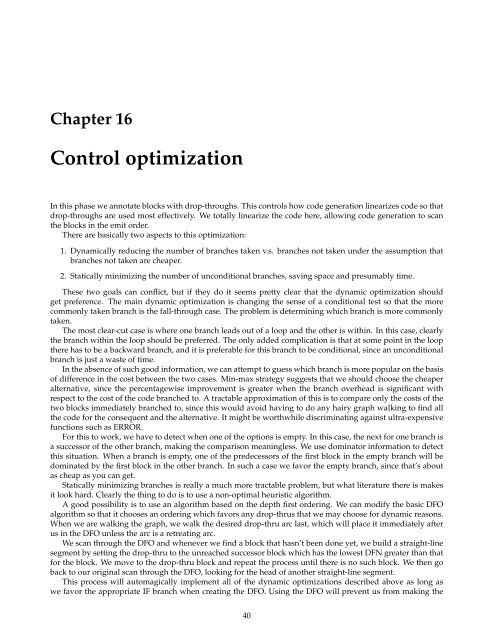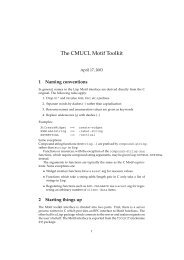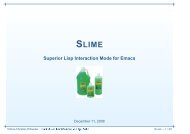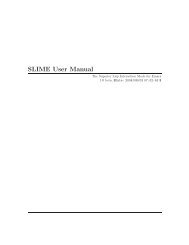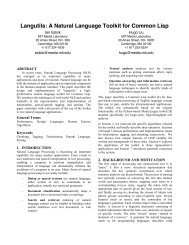Design of CMU Common Lisp.pdf - Common Lisp.net
Design of CMU Common Lisp.pdf - Common Lisp.net
Design of CMU Common Lisp.pdf - Common Lisp.net
You also want an ePaper? Increase the reach of your titles
YUMPU automatically turns print PDFs into web optimized ePapers that Google loves.
Chapter 16<br />
Control optimization<br />
In this phase we annotate blocks with drop-throughs. This controls how code generation linearizes code so that<br />
drop-throughs are used most effectively. We totally linearize the code here, allowing code generation to scan<br />
the blocks in the emit order.<br />
There are basically two aspects to this optimization:<br />
1. Dynamically reducing the number <strong>of</strong> branches taken v.s. branches not taken under the assumption that<br />
branches not taken are cheaper.<br />
2. Statically minimizing the number <strong>of</strong> unconditional branches, saving space and presumably time.<br />
These two goals can conflict, but if they do it seems pretty clear that the dynamic optimization should<br />
get preference. The main dynamic optimization is changing the sense <strong>of</strong> a conditional test so that the more<br />
commonly taken branch is the fall-through case. The problem is determining which branch is more commonly<br />
taken.<br />
The most clear-cut case is where one branch leads out <strong>of</strong> a loop and the other is within. In this case, clearly<br />
the branch within the loop should be preferred. The only added complication is that at some point in the loop<br />
there has to be a backward branch, and it is preferable for this branch to be conditional, since an unconditional<br />
branch is just a waste <strong>of</strong> time.<br />
In the absence <strong>of</strong> such good information, we can attempt to guess which branch is more popular on the basis<br />
<strong>of</strong> difference in the cost between the two cases. Min-max strategy suggests that we should choose the cheaper<br />
alternative, since the percentagewise improvement is greater when the branch overhead is significant with<br />
respect to the cost <strong>of</strong> the code branched to. A tractable approximation <strong>of</strong> this is to compare only the costs <strong>of</strong> the<br />
two blocks immediately branched to, since this would avoid having to do any hairy graph walking to find all<br />
the code for the consequent and the alternative. It might be worthwhile discriminating against ultra-expensive<br />
functions such as ERROR.<br />
For this to work, we have to detect when one <strong>of</strong> the options is empty. In this case, the next for one branch is<br />
a successor <strong>of</strong> the other branch, making the comparison meaningless. We use dominator information to detect<br />
this situation. When a branch is empty, one <strong>of</strong> the predecessors <strong>of</strong> the first block in the empty branch will be<br />
dominated by the first block in the other branch. In such a case we favor the empty branch, since that’s about<br />
as cheap as you can get.<br />
Statically minimizing branches is really a much more tractable problem, but what literature there is makes<br />
it look hard. Clearly the thing to do is to use a non-optimal heuristic algorithm.<br />
A good possibility is to use an algorithm based on the depth first ordering. We can modify the basic DFO<br />
algorithm so that it chooses an ordering which favors any drop-thrus that we may choose for dynamic reasons.<br />
When we are walking the graph, we walk the desired drop-thru arc last, which will place it immediately after<br />
us in the DFO unless the arc is a retreating arc.<br />
We scan through the DFO and whenever we find a block that hasn’t been done yet, we build a straight-line<br />
segment by setting the drop-thru to the unreached successor block which has the lowest DFN greater than that<br />
for the block. We move to the drop-thru block and repeat the process until there is no such block. We then go<br />
back to our original scan through the DFO, looking for the head <strong>of</strong> another straight-line segment.<br />
This process will automagically implement all <strong>of</strong> the dynamic optimizations described above as long as<br />
we favor the appropriate IF branch when creating the DFO. Using the DFO will prevent us from making the<br />
40


